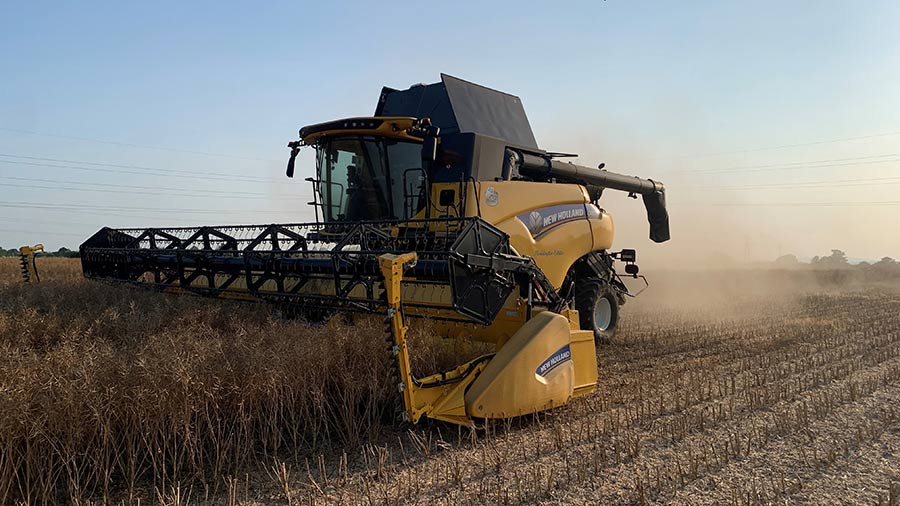Harvest 2023: Yields hit by early summer drought
 © Andrew Walters
© Andrew Walters Farmers continue to dodge the showers and dry as little of crops as they can – although the continued rain is turning what started out as an early harvest into one with plenty of delays.
See also: 5 mistakes when adopting regen farming and how to avoid them
Berwick-upon-Tweed
At Edrington Mains Farm, Jim Macfarlane has cut 22ha of Craft winter malting barley at an average of 16.8% moisture content and 62kg/hl specific weight.
“It achieved a poor yield of 6.7t/ha and high screenings of 3.4% through a 2.25mm sieve and 15.5% through 2.5mm, as it suffered from drought earlier in the year,” he says.
Nitrogen content was reasonable at 1.61%. “We have been reducing tillage; however, winter barley likes ploughed soil so now we use a low-disturbance subsoiler before drilling,” adds Jim.
Next to cut is 52ha of Aurelia and Matrix oilseed rape, after a glyphosate application on 14 July. “It hasn’t suffered too much from the weather. Hopefully, we can get going in the week,” says Jim.
After oilseed rape will be 73ha of Skyscraper and Bairstow winter wheat.
East Yorkshire
Further south, Jon Hodgson completed his oilseed rape harvest at Great Newsome Farm in South Frodingham on 29 July. The Acacia averaged 4.4t/ha while Ambassador did 4.8t/ha on a contract farm.
“Yields were changeable; cabbage stem flea beetle heavily affected yield,” he says.
On 30 July he moved into 4ha of Extase winter wheat, which came off at 15.5% moisture, having a good specific weight of 77kg/hl and 268 Hagberg, but a disappointing protein content of 10%.
There is another 134ha of winter wheat to cut, comprising Costello, Astronomer, Theodore and a four-way blend – but none of it is yet fit to combine.
“Crops have not had the sunshine, but they have coped and not lodged so far,” says Jon.
Gloucestershire
Across at Boddington Estates near Cheltenham, estate manager Andrew Walters started harvest on 13 July, with 60ha of Belfry hybrid six-row winter barley cut at an average moisture content of 14.5-17%.
It yielded 9.64t/ha over the weighbridge, with a disappointing specific weight of 56-61kg/hl.
“It is an early harvest; we usually start from 20 July, so we are a good week earlier,” says Andrew.
All cereal crops were direct-drilled for the first time and established well in the autumn.
“We are a high-pressure blackgrass farm, but levels are significantly lower this year, helped by direct-drilling and reduced soil disturbance,” he adds. “I’m really pleased with how the barley looked and yielded.”
After the winter barley harvest, Andrew cut 10ha of oilseed rape on 26 July at an average moisture content of 8.6% and a yield of just under 3t/ha.
“Our oilseed rape area was drastically lower this year due to crop failure from lack of moisture after drilling, so we decided to spray off most of it back in the autumn,” he says.
Next to cut is 160ha of Crusoe, Zyatt and Extase winter wheat, 30ha of Mulika spring wheat, 20ha of Isabel spring oats, and 60ha of Tundra winter beans.
Surrey
Yields have also been variable at GL Porter & Sons’ Clare Park Farm, near Farnham.
Giles Porter has completed Ambassador, Acacia and Aurelia oilseed rape, with yields ranging from 2.7t to 3.9t/ha and moisture content between 7.5% and 8.5%.
Next was 63ha of Kingsbarn winter barley, which yielded 7-9.5t/ha at average moisture content of 16%.
“Fields looked good coming into winter, but heavy ground didn’t look good after the spring, although disease has not been bad,” says Giles.
The Crusoe winter wheat was affected by the heat in June, and the 300ha cut so far of the 1,000ha total came off at an average moisture content of 15.5% and yield of 8-8.5t/ha.
“Most of the wheat is ready to cut, but we’ve had lots of rain and I am concerned on quality,” says Giles.
Spring barley, winter oats, and winter beans are next, and he expects yields to be only average on the better ground.

